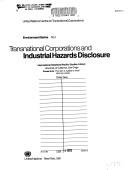| Listing 1 - 10 of 12 | << page >> |
Sort by
|
Book

ISBN: 9783031126734 Year: 2022 Publisher: Cham Springer International Publishing :Imprint: Springer
Abstract | Keywords | Export | Availability | Bookmark
 Loading...
Loading...Choose an application
- Reference Manager
- EndNote
- RefWorks (Direct export to RefWorks)
Disclosure of information --- Internet in public administration --- Law and legislation. --- Disclosure laws
Book
ISBN: 3031126726 3031126734 Year: 2022 Publisher: Cham, Switzerland : Springer International Publishing,
Abstract | Keywords | Export | Availability | Bookmark
 Loading...
Loading...Choose an application
- Reference Manager
- EndNote
- RefWorks (Direct export to RefWorks)
Disclosure of information --- Internet in public administration --- Law and legislation. --- Disclosure laws
Book
ISBN: 1108364934 1108365191 1108365450 1316508471 1316535215 110836571X 1108366759 1107145147 110836649X 1108363636 Year: 2017 Publisher: Cambridge : Cambridge University Press,
Abstract | Keywords | Export | Availability | Bookmark
 Loading...
Loading...Choose an application
- Reference Manager
- EndNote
- RefWorks (Direct export to RefWorks)
The duty to keep customer information confidential affects banks on a daily basis. Bank secrecy regimes around the world differ and multi-national banks can find themselves in conflicted positions with a duty to protect information in one jurisdiction and a duty to disclose it in another. This problem has been heightened by the international trend promoting information disclosure in order to combat tax evasion, money laundering and terrorist financing. The US Foreign Account Tax Compliance Act (FATCA) is perhaps the most well-known. At the same time, data protection legislation is proliferating around the world. This book offers a holistic treatment of bank secrecy in major financial jurisdictions around the world, east and west, by jurisdictional experts as well as chapters by subject specialists covering the related areas of confidentiality in its broader privacy context, data protection, conflicts of laws, and exchange of information for the purposes of combatting international crime.
Confidential communications --- Banks and banking --- Disclosure of information --- Data protection --- Habeas data --- Privacy, Right of --- Disclosure laws --- Banking law --- Bank secrecy --- Banking. --- Records and correspondence --- Law and legislation.
Book
ISBN: 9264942394 Year: 2021 Publisher: Paris, France : Organization for Economic Cooperation & Development,
Abstract | Keywords | Export | Availability | Bookmark
 Loading...
Loading...Choose an application
- Reference Manager
- EndNote
- RefWorks (Direct export to RefWorks)
Despite big societal changes, and many labour market, educational and public policy initiatives, women are still paid less than men. This report presents the first stocktaking of pay transparency tools across OECD countries and explores how such policies can help level the playing field for women and men at work.
Wages --- Disclosure of information --- Universities and colleges --- Disclosure laws --- Women --- Women employees --- Women. --- Law and legislation. --- College employees. --- University employees --- Employees --- Salaries, etc.
Book
ISBN: 9781784714710 1784714712 Year: 2015 Publisher: Cheltenham Edward Elgar Publishing
Abstract | Keywords | Export | Availability | Bookmark
 Loading...
Loading...Choose an application
- Reference Manager
- EndNote
- RefWorks (Direct export to RefWorks)
Following the financial crisis of 2008 and various scandals around the world, there has been a global movement towards greater transparency with international exchanges of information in tax matters. This book provides a comprehensive overview of the main developments, and an analysis of the structure and content of the various existing instruments and models.Xavier Oberson covers the topic broadly, discussing double taxation treaties, TIEAs, the OECD multinational convention, European Directives, FATCA and the Swiss Rubik model. He further provides an analysis of the new OECD common reporting standard of automatic exchange of information, and distinguishes between the various substantial rights (human rights, constitutional rights) and procedural rights that can be used during the different phases of information exchange.Lawyers and tax specialists looking to further their knowledge will find this book to be an invaluable reference. Students and academics in law, tax or economics will appreciate the clear overview and find many useful insights. Practitioners such as taxpayers, bankers and finance professionals will find this to be an informative read.
Tax law --- International law --- Tax administration and procedure --- Disclosure of information --- Transparency in government --- Disclosure laws --- Tax practice --- Tax procedure --- Taxation --- International cooperation. --- Law and legislation. --- International cooperation --- Law and legislation
Book
ISBN: 9789211128307 9789210550192 9210550196 9211128307 Year: 2012 Volume: *2 Publisher: United Nations
Abstract | Keywords | Export | Availability | Bookmark
 Loading...
Loading...Choose an application
- Reference Manager
- EndNote
- RefWorks (Direct export to RefWorks)
In addition to these issues common to the 2004 volume and this Sequel, this study identifies significant areas of change in stakeholder approaches to the issue of transparency. The first is the emergence of investor responsibilities as a consideration within the transparency context. The second is the emergence of transparency issues within ISDS. This study focuses particularly on transparency in ISDS and the implications of this conceptual shift manifested in the dispute resolution context. This study also considers transparency concerns as a component of a more generalised interest in the impact of procedural matters in ISDS. A key issue is the appearance of transparency and public participation-related provisions in recent IIAs and the sustainable development implications of such approaches. The aim of this paper is to update the first edition of UNCTAD's Pink Series paper on transparency. It seeks to examine: The way in which traditional transparency issues have been addressed in international investment agreements (IIAs) since 2004, The emergence of investor responsibilities as a consideration within transparency issues, and The introduction of a transparency dimension into investor-State dispute settlement (ISDS). In analysing these issues, this paper outlines possible sustainable development implications of the different transparency-related formulations used in IIAs and points to some of the most progressive provisions that are appearing more frequently in investment instruments. It is clear that certain key elements identified in the first edition paper on transparency have remained live issues. For example, it is necessary to continue exploring formulations for clauses where States are addressees of transparency obligations in IIAs and the sustainable development implications of such formulations. Secondly, the substantive scope and content of transparency obligations remains a central issue. Of most concern from a development perspective is the scope and extent of the obligation and the kind of requirements placed on the host States in this regard. These aspects are interlinked with a third issue, namely the different mechanisms available to implement transparency obligations in IIAs and the development impacts of particular methods of disclosure. In a practical sense, the development issues surround the intrusiveness of the obligation, the technical capacity of developing countries to fulfil expansive transparency obligations, and the resulting cost to such countries.
Droit international économique --- Droit économique (Droit international) --- Droit économique international --- Economic policy [Foreign ] --- Economic relations [Foreign ] --- Economics [International ] --- Economische betrekkingen [Internationale ] --- Foreign economic policy --- Interdependence of nations --- International economic policy --- International economic relations --- International economics --- Internationale economische betrekkingen --- New international economic order --- Relations économiques internationales --- E-books --- Disclosure of information --- Investments, Foreign --- Economic policy, Foreign --- Economic relations, Foreign --- Economics, International --- Foreign economic relations --- Economic policy --- International relations --- Economic sanctions --- Disclosure laws --- Law and legislation --- Foreign investments --- --Transparency issues --- Investments --- Law, Politics & Government --- Law, General & Comparative --- Information, Disclosure of --- Truthfulness and falsehood

ISBN: 9211043751 Year: 1991 Volume: vol 1 Publisher: New York, N.Y.
Abstract | Keywords | Export | Availability | Bookmark
 Loading...
Loading...Choose an application
- Reference Manager
- EndNote
- RefWorks (Direct export to RefWorks)
Industrial economics --- Hygiene. Public health. Protection --- Environmental protection. Environmental technology --- Disclosure of information --- -Hazardous substances --- -Industrial safety --- -International business enterprises --- -Risk communication --- Communication of risk information --- Communication of technical information --- Business enterprises, International --- Corporations, International --- Global corporations --- International corporations --- MNEs (International business enterprises) --- Multinational corporations --- Multinational enterprises --- Transnational corporations --- Business enterprises --- Corporations --- Joint ventures --- Industrial accidents --- Industries --- Job safety --- Occupational hazards, Prevention of --- Occupational health and safety --- Occupational safety and health --- Prevention of industrial accidents --- Prevention of occupational hazards --- Safety, Industrial --- Safety engineering --- Safety measures --- Safety of workers --- Accidents --- System safety --- Dangerous chemicals --- Dangerous goods --- Dangerous materials --- Dangerous substances --- Hazardous chemicals --- Hazardous goods --- Hazardous materials --- Hazmats --- Chemicals --- Materials --- Information, Disclosure of --- Truthfulness and falsehood --- Law and legislation --- Prevention --- Hazardous substances --- Industrial safety --- International business enterprises --- Risk communication --- Corporation law --- Accident law --- Employers' liability --- Factory laws and legislation --- Safety regulations --- Toxic torts --- Disclosure laws

ISBN: 0471569755 Year: 2004 Publisher: Hoboken Wiley
Abstract | Keywords | Export | Availability | Bookmark
 Loading...
Loading...Choose an application
- Reference Manager
- EndNote
- RefWorks (Direct export to RefWorks)
174.7 --- 343 --- 657.632 --- audit --- boekhouding, controle --- boekhoudkundige fraude --- Corporations --- -Corporations --- -Disclosure of information --- -Business corporations --- C corporations --- Corporations, Business --- Corporations, Public --- Limited companies --- Publicly held corporations --- Publicly traded corporations --- Public limited companies --- Stock corporations --- Subchapter C corporations --- Business enterprises --- Corporate power --- Disincorporation --- Stocks --- Trusts, Industrial --- Information, Disclosure of --- Truthfulness and falsehood --- Contract. Eerlijkheid. Bedrog --- Strafwetenschappen--(algemeen) --- Frauds and errors --- Accounting --- Corrupt practices --- -Law and legislation --- Law and legislation --- Disclosure of information --- Law and legislation. --- Accounting. --- Corrupt practices. --- -Contract. Eerlijkheid. Bedrog --- 657.632 Frauds and errors --- 343 Strafwetenschappen--(algemeen) --- 174.7 Contract. Eerlijkheid. Bedrog --- -657.632 Frauds and errors --- Business corporations --- Disclosure laws --- Corporate bribery --- Corporate corruption --- Corporate crime --- Business ethics --- Commercial crimes --- Corporate accounting --- Corporate financial reporting --- Corporation accounting --- Accounting&delete&
Book
ISBN: 1859660614 Year: 1994 Publisher: London Graham and Trotman
Abstract | Keywords | Export | Availability | Bookmark
 Loading...
Loading...Choose an application
- Reference Manager
- EndNote
- RefWorks (Direct export to RefWorks)
Hazardous substances --- -Industrial safety --- -Disclosure of information --- -Environmental law, International --- #A9503A --- 13.04.a --- International environmental law --- International law --- Common heritage of mankind (International law) --- Information, Disclosure of --- Truthfulness and falsehood --- Industrial accidents --- Industries --- Job safety --- Occupational hazards, Prevention of --- Occupational health and safety --- Occupational safety and health --- Prevention of industrial accidents --- Prevention of occupational hazards --- Safety, Industrial --- Safety engineering --- Safety measures --- Safety of workers --- Accidents --- System safety --- Dangerous chemicals --- Dangerous goods --- Dangerous materials --- Dangerous substances --- Hazardous chemicals --- Hazardous goods --- Hazardous materials --- Hazmats --- Chemicals --- Materials --- Law and legislation --- Wettelijke en contractuele aansprakelijkheid ; Zaken ; Algemeen --- Prevention --- Disclosure of information --- Environmental law, International. --- Industrial safety --- Law and legislation. --- Environmental law, International --- Disclosure laws --- Accident law --- Employers' liability --- Factory laws and legislation --- Safety regulations --- Toxic torts

ISBN: 9780521699617 9780521876179 0521876176 9780511510533 0511275005 9780511275005 0511510535 0511273479 9780511273476 9780511275708 0511275706 9786610815876 6610815879 0521699614 1107172462 1280815876 0511321694 0511274262 9780511274268 9781107172463 9781280815874 Year: 2007 Publisher: New York : Cambridge University Press,
Abstract | Keywords | Export | Availability | Bookmark
 Loading...
Loading...Choose an application
- Reference Manager
- EndNote
- RefWorks (Direct export to RefWorks)
Governments in recent decades have employed public disclosure strategies to reduce risks, improve public and private goods and services, and reduce injustice. In the United States, these targeted transparency policies include financial securities disclosures, nutritional labels, school report cards, automobile rollover rankings, and sexual offender registries. They constitute a light-handed approach to governance that empowers citizens. However, as Full Disclosure shows these policies are frequently ineffective or counterproductive. Based on a comparative analysis of eighteen major policies, the authors suggest that transparency policies often produce information that is incomplete, incomprehensible, or irrelevant to the consumers, investors, workers, and community residents who could benefit from them. Sometimes transparency fails because those who are threatened by it form political coalitions to limit or distort information. To be successful, transparency policies must place the needs of ordinary citizens at centre stage and produce information that informs their everyday choices.
Government information --- -Transparency in government --- -Disclosure of information --- -#SBIB:35H510 --- #SBIB:35H24 --- 352.38 --- Information, Disclosure of --- Truthfulness and falsehood --- Government in the sunshine --- Openness in government --- Sunshine, Government in the --- Transparence in government --- Public administration --- Information, Government --- Freedom of information --- Public records --- Access control --- Government policy --- -Law and legislation --- Openbaarheid van bestuur, ombudsdienst, ... --- Informatiemanagement bij de overheid --- Transparency in government --- Disclosure of information --- Transparence (Sciences sociales) --- Divulgation d'informations --- Divulgation d'information --- -Information, Disclosure of --- -Openbaarheid van bestuur, ombudsdienst, ... --- #SBIB:35H510 --- Disclosure laws --- Open government (Transparency in government) --- Law and legislation --- Openbaarheid van bestuur, ombudsdienst, .. --- Information sur l'Etat --- Law and legislation. --- Politique gouvernementale --- Droit --- Openbaarheid van bestuur, ombudsdienst, . --- Openbaarheid van bestuur, ombudsdienst, --- Social Sciences --- Political Science --- Transparency (Ethics) in government
| Listing 1 - 10 of 12 | << page >> |
Sort by
|

 Search
Search Feedback
Feedback About UniCat
About UniCat  Help
Help News
News